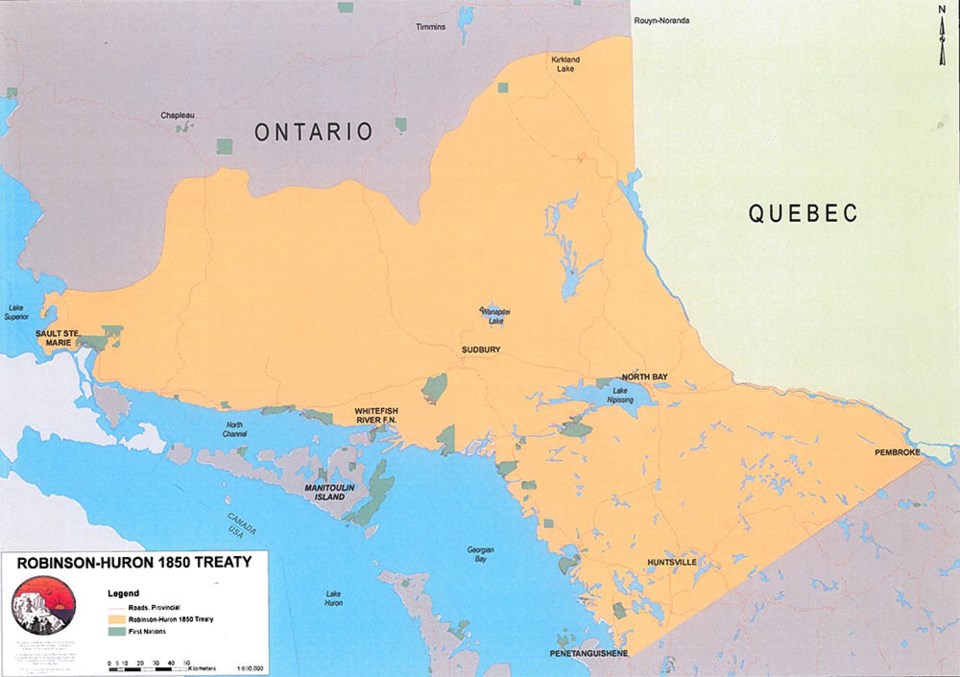The advocacy body for Robinson Huron Treaty signatories is looking to resolve a series of long-standing issues surrounding the overlapping of treaty boundaries with other treaty organizations and rights holders in Ontario.
Robinson Huron Waawiindaamaagewin (RHW) says the latest round of funding received through the federal government’s Nation Rebuilding Program will enable it to carry out geographic information system (GIS) mapping of its treaty boundaries with its own GIS specialist, and support ongoing work in the development of protocols aimed at addressing unresolved boundary issues with other groups.
A total of 10 Indigenous groups in Ontario received just over $4 million in funds through the five-year, $100 million program, which was introduced by the federal government in 2018 to facilitate activities projects related to nation building.
“One of the biggest issues that we have in the treaty territory is the overlapping boundary of our treaty organizations, other rights holders within the northeastern Ontario area,” said Earl Commanda, executive director for RHW. “We’ve taken on a strategy to begin to sit down with our brother First Nations, to begin to develop protocols around overlapping usage. This is all about the hunting, fishing, trapping territory that is guaranteed by treaty - protected by treaty - and so now, we’re hoping to end up with a common understanding with those groups.”
“A part of the understanding, of course, is the Canadian constitution recognition of Métis rights within Robinson Huron Treaty territory.”
The advocacy body has met with both Chippewas of Nawash First Nation, Saugeen First Nation and Wahta Mohawk Territory about overlapping hunting and fishing rights with Robinson Huron Treaty territory, and will now look toward developing protocols with those groups.
Commanda says there are also some unresolved boundary issues with rights holders within Robinson Superior Treaty and Treaty 9 territories that need to be addressed in the future.
“This falls in line with the objectives of the chiefs overall in terms of asserting their rights and jurisdiction within the treaty territory,” he said. “We’re not at the stage where we can actually clarify the boundaries of the treaty yet, but we will be able after we finish with this additional funding from the federal government to take a look at those boundary issues - and perhaps provide some solutions with our neighbouring First Nations that we have boundary issues with.”
The executive director for RHW points to Ottawa and the province negotiating a $1.1 billion settlement with Williams Treaties First Nations in central and southern Ontario in 2018. Commanda says that a result of the settlement, Williams Treaties First Nations now lay claim to hunting rights all the way up to Lake Nippissing, which he says makes up almost half of Robinson Huron Treaty territory.
All 21 chiefs within Robinson Huron Treaty territory issued a letter to both the prime minister and premier last February, maintaining they did not consent to both levels of government settling claims with other groups within its treaty boundaries.
“If you’re going to settle these things, you should at least be consulting with our 21 First Nations over these matters,” Commanda said.
Chiefs within Robinson Huron territory have compiled a list of 50 action items for RHW to pursue over the next five to 10 years that revolve around nation building and establishing a political voice at both the federal and provincial levels of government.
“We are everything outside of the annuities challenge, dealing with other matters related to the treaty territory,” Commanda said.
The RHW acknowledged the 170th anniversary of the Robinson Huron Treaty in Sault Ste. Marie this past September by passing a formal declaration and series of protocols surrounding how the treaty organization will assert itself in dealings with the federal and provincial governments going forward.
More information, including a transcript of the Robinson Huron Treaty document, can be found on the RHW website.
